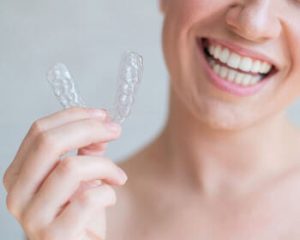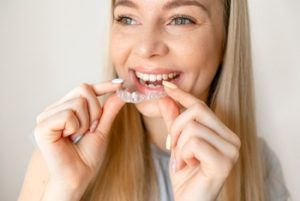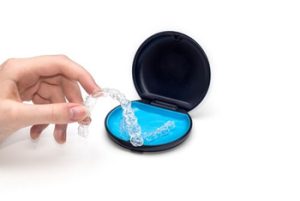If you’re using Invisalign aligners to achieve a straighter smile, you’re likely enjoying the flexibility they offer over traditional metal braces. However, if you’re a frequent gum chewer, you might wonder whether you can still indulge in the habit. Can you chew gum with Invisalign? The simple answer? It’s best to avoid it. Unlike traditional braces, where gum can get tangled in brackets, Invisalign treatment presents its own challenges when it comes to chewing gum. Let’s break down why it’s not recommended and what alternatives you can consider.
Why Chewing Gum with Invisalign Isn’t Ideal
If you’re considering chewing gum with Invisalign, you may want to think twice. While gum may seem harmless, it can cause several issues that interfere with your orthodontic treatment and oral health. Here’s why avoiding gum while wearing Invisalign aligners is the best choice:
 1. It Can Distort Your Aligners
1. It Can Distort Your Aligners
Invisalign aligners are made from custom-made plastic that is carefully designed to fit snugly over your teeth. However, excessive gum chewing can put pressure on the aligners, causing them to bend or lose their proper fit. If this happens, your aligners won’t work as effectively, slowing your treatment progress and affecting your smile transformation.
2. Sticky Residue Can Build Up
Even sugar-free chewing gum can leave a sticky film on your removable aligners, making them difficult to clean. This sticky residue can attract food particles and bacteria, boosting the risk of plaque buildup, tooth decay, and potential cavities. Over time, poor aligner hygiene can negatively impact your dental health.
3. It May Cause Dry Mouth
Normally, chewing gum stimulates saliva production, which helps wash away bacteria and food debris. However, wearing aligners can disrupt this process by acting as a barrier, leading to reduced saliva flow. A dry mouth can cause bad breath and increase the risk of oral hygiene problems, including gum irritation and bacterial growth.
4. Gum Can Get Stuck in Aligners
Unlike traditional braces, where gum gets caught in wires and brackets, plastic aligners trap gum differently. Gum may stick to the surface of your aligners, making it difficult to remove and leading to a messy, unhygienic situation. The more gum gets stuck, the harder it is to keep your aligners clean, increasing the likelihood of bacterial buildup and potential drawbacks to your treatment.
5. It Can Make Wearing Aligners Uncomfortable
Chewing gum while wearing Invisalign can feel unnatural and uncomfortable. Aligners are designed to be worn securely, and gum chewing can create unnecessary movement, causing discomfort and possibly shifting the aligners out of place. If they don’t stay in position, your orthodontic treatment may not progress as planned.
6. Increased Risk of Bacterial Growth
Since food particles and sticky residue from gum can become trapped inside your aligners, this environment can encourage the rapid growth of bacteria. This could lead to bad breath, potential cavities, and other oral health concerns.
Is Sugar-Free Gum a Safer Option?
Some believe that sugar-free gum is a better alternative since it doesn’t contribute to tooth decay. However, even sugar-free chewing gum is sticky enough to affect how aligners fit. If you’re tempted to chew gum, it’s best to remove your aligners first.
Invisalign Do’s and Don’ts: How to Handle Gum Chewing
What You Should Do:
- Remove aligners before chewing gum. If you must chew gum, always take your aligners out first and store them properly.
- Stick to sugar-free options. If you chew gum after removing your aligners, choose sugar-free varieties to reduce the risk of tooth decay and plaque buildup.
- Maintain good oral hygiene. After chewing gum, rinse your mouth or brush your teeth before putting your aligners back in.
- Clean your aligners thoroughly. Avoid using toothpaste on them, as it can be abrasive. Instead, wash them with lukewarm water and mild soap.
What You Should Avoid:
- Chewing gum while wearing aligners. This can cause damage to the aligners and affect their fit.
- Consuming sticky or hard candies. These can increase the likelihood of plaque buildup and may even crack your aligners.
- Leaving your aligners out for too long. The more time they spend outside your mouth, the longer your treatment will take.
- Forgetting to clean aligners after eating. Food residue and bacteria can get trapped, leading to poor oral hygiene.
Following these guidelines, you can keep your Invisalign aligners in excellent condition while ensuring your orthodontic treatment stays on track.
Alternative Ways to Keep Your Breath Fresh
If you chew gum for freshness, here are some comfortable alternatives that won’t interfere with your orthodontic treatment:
- Mouthwash: A quick rinse with good oral hygiene mouthwash helps eliminate bad breath.
- Sugar-free mints: Unlike gum, sugar-free mints dissolve quickly and don’t stick to aligners.
- Staying hydrated: Drinking plenty of lukewarm water prevents dry mouth and keeps your breath fresh.
- Crunchy fruits and vegetables: Foods like apples, carrots, and celery naturally stimulate saliva flow, benefiting your dental health.
Frequently Asked Questions (FAQs)
- How long should I wait after removing my aligners to chew gum?
You can chew gum immediately after removing your aligners, but be sure to clean your mouth before putting them back in.
- Will gum chewing slow down my Invisalign progress?
Yes, if aligners become distorted due to gum chewing, they may not fit properly, delaying your treatment.
- Can I use chewing gum as a substitute for brushing after meals?
No, gum should never replace brushing. Proper oral hygiene practices are necessary to prevent plaque buildup and ensure a healthy smile.
- What if I accidentally chew gum with my aligners?
If you mistakenly chew gum while wearing aligners, remove them immediately and clean them thoroughly with lukewarm water to prevent buildup.
- Is it safe to chew gum after removing Invisalign?
Yes, but ensure you brush or rinse your mouth before putting your aligners back in to maintain good oral hygiene.
- Can chewing gum help with discomfort from Invisalign?

Some believe chewing gum helps with mild jaw soreness, but avoiding it and using other relief methods, such as cold compresses or soft foods is best.
- Will chewing gum affect the alignment of my teeth?
Yes, chewing gum excessively while wearing Invisalign aligners can impact their fit and potentially lead to treatment delays.
Final Thoughts: Should You Chew Gum with Invisalign?
While Invisalign offers a comfortable alternative to traditional braces, certain habits—like chewing gum—should be adjusted to protect your investment. If you need to chew gum, always remove your aligners first and follow proper care practices to maintain your oral health. Keeping your aligners in excellent condition will help you stay on track toward a straighter smile.
Considering Invisalign?
If you’re considering starting Invisalign treatment or need advice on maintaining your removable aligners, book a consultation with Advanced Dental Care at (02) 6188 7103. They can provide expert guidance on how to care for your aligners while ensuring your journey to a beautiful smile stays on course.
References
- Oral Health Foundation. (n.d.). Can chewing sugar-free gum help protect your teeth? Dental Health. Retrieved from https://www.dentalhealth.org/sugar-free-chewing-gum#:~:text=Can%20chewing%20sugar%2Dfree%20gum,bad%20breath%20may%20be%20reduced.
- Colgate. (n.d.). How to practice oral hygiene with braces. Retrieved from https://www.colgate.com/en-us/oral-health/kids-oral-care/how-to-practice-oral-hygiene-with-braces.
- Mayo Clinic. (n.d.). Cavities – Symptoms and causes. Retrieved from https://www.mayoclinic.org/diseases-conditions/cavities/symptoms-causes/syc-20352892.







